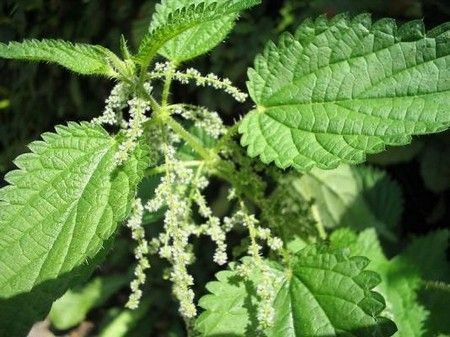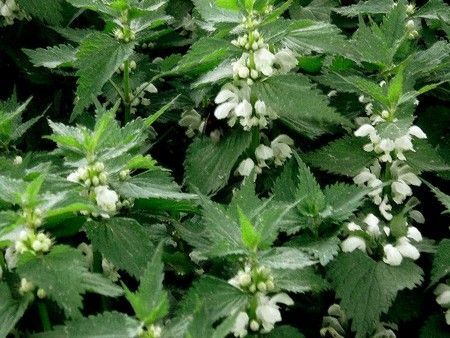Deaf nettle is found almost everywhere;it can be found in the forest, in the city, on the plots of land. This plant is incredibly useful, as it is able to display a lot of medicinal properties. Why is it called "deaf"?In contrast to nettle, the deaf does not "burn", which allows it to be collected without gloves.

Characteristics of the plant
The clearness is white, the people have a deaf nettle, is a herbaceous plant belonging to the family of labial flowers. It has a creeping rhizome and a hollow, non-branching stem, whose height can reach 60 cm. Leaflets on petioles, opposite, cordate or ovate, are located on stalks crosswise, forming nodes. Flowers are painted in a white or yellowish tint, located in green five-toothed calyx. At the end of the flowering period, a fruit is formed, which breaks up into four dark nuts.
Having looked at the photo, you can consider the obvious similarity of ordinary and deaf nettle.

. Useful properties of
Deaf nettle has a long list of medicinal properties that are used for a variety of diseases:
- expectorant;
- astringent;
- is a diuretic;
- hemostatic;
- is an anti-inflammatory;
- antiallergic;
- is a blood purifier.
The clearing in folk medicine
This plant is used for catarrhal diseases, as well as for the treatment of angina. Expectorant properties of a clearing are used to excrete sputum from the bronchi, which becomes relevant in diseases of the respiratory system.
Deaf nettle is quite effective in treating various skin diseases;it helps to heal wounds, relieves inflammation and promotes early regeneration of skin.
Clear white is good for the normalization of the nervous system. Being a natural antidepressant, it helps to drive away insomnia, overcome stress, neurosis and relieves irritability. Decoctions and infusions of this plant eliminate headaches and relieve fatigue.

In medicine, the dark blue is used in such cases:
- of the urinary system;
- painful menstruation;
- bronchitis;
- tracheitis;
- bronchial asthma;
- pneumonia;
- of the disease of the spleen;
- diseases of the gastrointestinal tract;
- stroke;
- anemia;
- Nervous Diseases;
- Allergies;
- bleeding - uterine, pulmonary, nasal, hemorrhoidal, intestinal;
- liver disease;
- of jaundice;
- malaria;
- insomnia;
- diarrhea;
- dysentery;
- anemia;
- rash on the body;
- Eczema;
- urticaria;
- furunculosis.
Note! With such a long list of indications, deaf nettle is a harmless plant, which makes its use permissible for diathesis in children.
By making baths based on a plant, you can significantly improve the health of patients suffering from hemorrhoids, and the external use of compresses and decoctions positively affects the skin condition - the wounds are healed and the effects of burns are eliminated.
The clearing helps to get rid of pains in the chest and neck area. A decoction of the plant is highly effective in nephritis, cystitis and urethritis. Infusion of flowers is considered an excellent blood cleanser.

Important! If you take into account contraindications and do not violate the indicated daily dose, then the use of the aerial part of the plant will be absolutely safe. But remember that the root of the deaf nettle is used only in the form of an alcohol tincture to relieve dental and headaches, and also for insomnia!
Drugs of deaf nettle
You can prepare a decoction based on the glue, a tincture on alcohol, water infusion and vitamin tea. For medicinal purposes, it is recommended to use leaves and inflorescences of the plant. They dry them together with the tops, since they are especially rich in useful substances.
It is known that flowers of deaf nettle contain a large amount of nectar, so it is preferable to dry them not under direct sunlight, but under canopies or in shaded premises with good ventilation. The collected parts of the plant are cut and unfolded on paper or cloth, periodically turning over. The dried raw material is recommended to be stored in tightly closed containers, since the intense scent of the nettle will attract insects, and the harvested medicinal material will be spoiled.
Decoction
- Place a tablespoon of dry raw material in a saucepan.
- Pour a glass of water and bring the mixture to a boil.
- Leave it for 15 minutes.
- Cool, filter.
Take a ready-made decoction of 100 ml three times a day.
Alcohol tincture
- Place 10 g of dried inflorescences in a glass container.
- Pour 300 ml of alcohol 40% or vodka.
- Insist for a week at room temperature.
Recommendation! During this time, you must periodically shake the contents of the bottle!
- To profile.
Take tincture three times a day for 30 drops.
Water infusion
- Place a tablespoon of chopped dry grass in a thermos bottle.
- Pour 150 ml of boiling water.
- Close tightly and leave for 20 minutes.
- To profile.
The obtained infusion is used for baths. The procedure is carried out daily for a week. The recommended time for baths is about 20 minutes.
Vitamin tea
- Mix dry yarrow and flowers of the nettle.
- 2 teaspoons of a dry mixture pour a glass of boiling water.
- Boil for 7 minutes, remove from heat.
- Profile and drink three glasses a day.
Caution - contraindications!
Deaf nettle does not contain any poisonous substances in its composition, therefore it is believed that an overdose of its drugs can not have consequences. But, at the same time, long-term administration of funds based on this plant is not allowed with:
- hypotension;
- increased blood clotting;
- atonic locks.
It is strictly forbidden to take preparations of deaf nettle during pregnancy, as they increase contractions of the uterine musculature.
